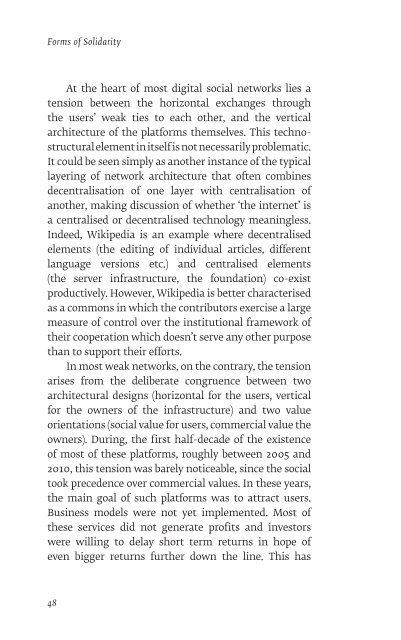KTub8
KTub8
KTub8
Create successful ePaper yourself
Turn your PDF publications into a flip-book with our unique Google optimized e-Paper software.
Forms of Solidarity<br />
At the heart of most digital social networks lies a<br />
tension between the horizontal exchanges through<br />
the users’ weak ties to each other, and the vertical<br />
architecture of the platforms themselves. This technostructural<br />
element in itself is not necessarily problematic.<br />
It could be seen simply as another instance of the typical<br />
layering of network architecture that often combines<br />
decentralisation of one layer with centralisation of<br />
another, making discussion of whether ‘the internet’ is<br />
a centralised or decentralised technology meaningless.<br />
Indeed, Wikipedia is an example where decentralised<br />
elements (the editing of individual articles, different<br />
language versions etc.) and centralised elements<br />
(the server infrastructure, the foundation) co-exist<br />
productively. However, Wikipedia is better characterised<br />
as a commons in which the contributors exercise a large<br />
measure of control over the institutional framework of<br />
their cooperation which doesn’t serve any other purpose<br />
than to support their efforts.<br />
In most weak networks, on the contrary, the tension<br />
arises from the deliberate congruence between two<br />
architectural designs (horizontal for the users, vertical<br />
for the owners of the infrastructure) and two value<br />
orientations (social value for users, commercial value the<br />
owners). During, the first half-decade of the existence<br />
of most of these platforms, roughly between 2005 and<br />
2010, this tension was barely noticeable, since the social<br />
took precedence over commercial values. In these years,<br />
the main goal of such platforms was to attract users.<br />
Business models were not yet implemented. Most of<br />
these services did not generate profits and investors<br />
were willing to delay short term returns in hope of<br />
even bigger returns further down the line. This has<br />
48


